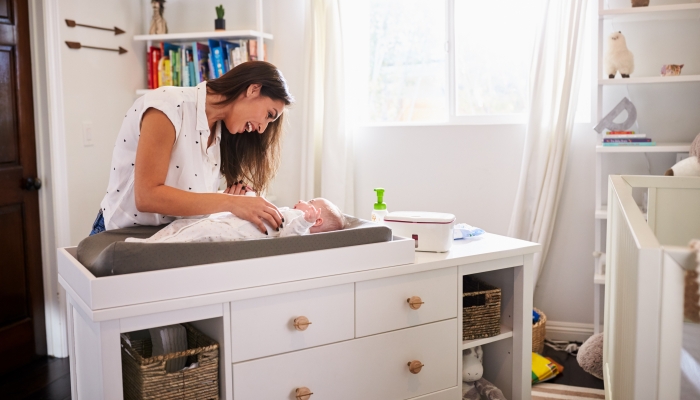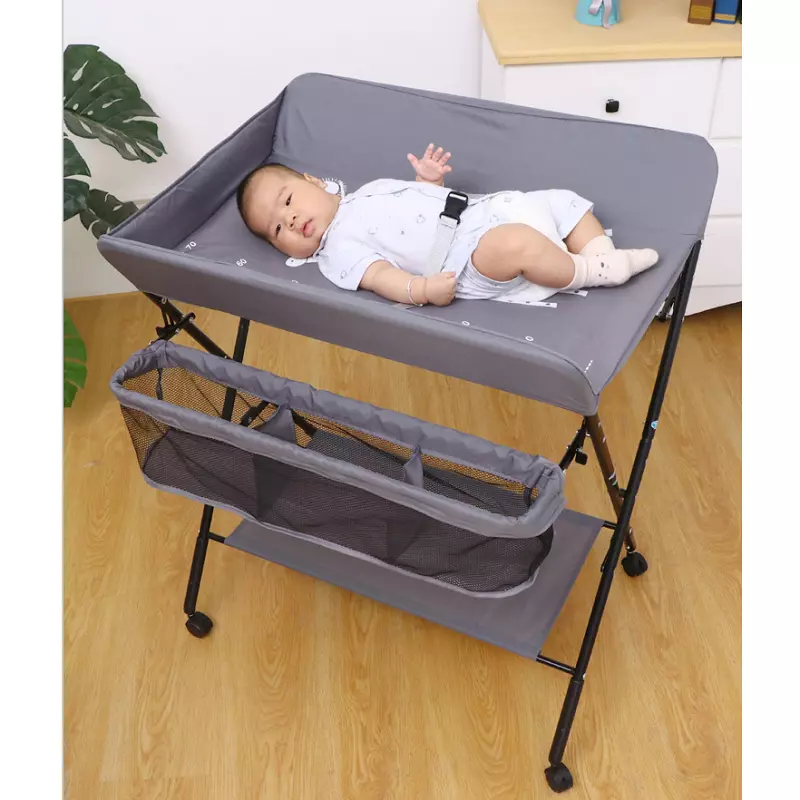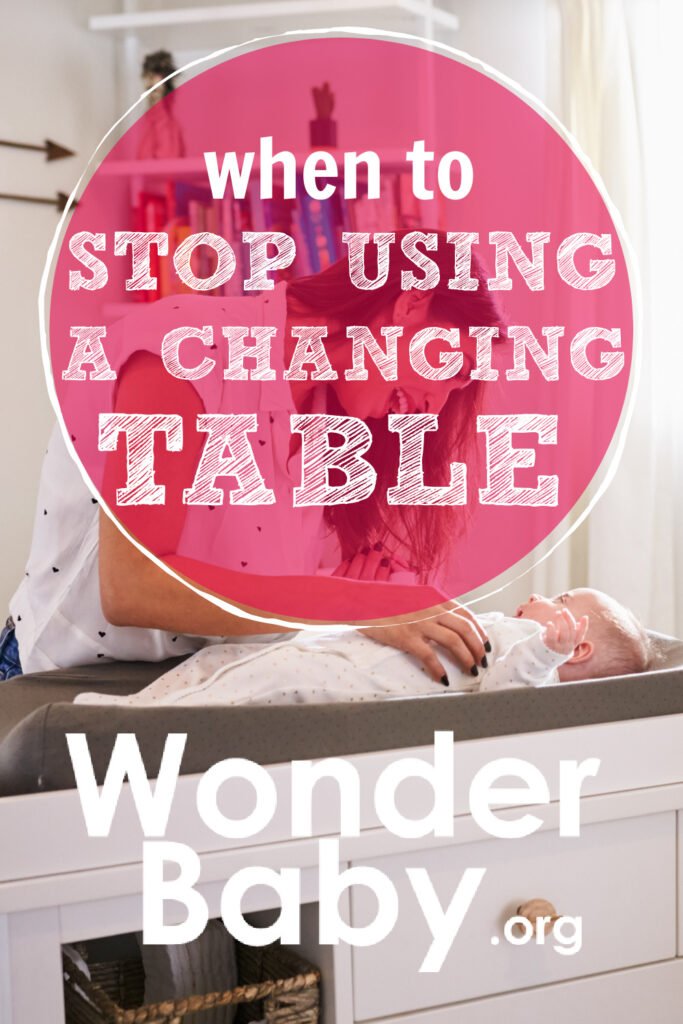A changing table is great for baby care. But kids outgrow them.
Most parents wonder when to stop using a changing table. The answer lies in your child’s growth and safety. Once your child starts wiggling or rolling, the table may not be safe. As toddlers grow, they may resist staying still on the table.
This can lead to falls or injuries. Safety and convenience are key in deciding when to switch. Many parents find a safer option on the floor. This change can make diaper time easier. It’s important to adapt to your child’s needs. This ensures a smooth transition and keeps them safe. In this post, we explore the signs that it’s time to retire the changing table.

Credit: sljesuits.com
Signs Your Baby Is Outgrowing The Changing Table
Knowing when to stop using a changing table can be a bit tricky for new parents. As your little one grows, they will show signs that it’s time to move on to other diaper-changing solutions. Understanding these signals will help ensure their safety and your convenience. So, what should you look for as indicators that your baby is outgrowing the changing table?
Physical Growth Indicators
One of the first signs is your baby’s size. If your baby begins to look cramped or uncomfortable on the changing table, it might be time to consider alternatives. Changing tables usually have weight and size limits. Ensure your baby isn’t exceeding these limits for their safety. You don’t want the table to tip over or become unstable.
Also, check if your baby’s legs hang off the edge. This can be uncomfortable for them and difficult for you. A secure and stable environment is essential during diaper changes. Safety is a priority, and you need to be sure the space accommodates your child’s growing size.
Increased Mobility
As your baby becomes more active, they may start rolling, squirming, or even trying to crawl away during diaper changes. This increased mobility can make changing tables unsafe. You don’t want your baby to roll off and get injured. Their movements demand more space and freedom, which a changing table may not offer.
Consider how your baby’s mobility affects your diaper-changing routine. Are they becoming more adventurous? Are they constantly trying to grab items off the table? If yes, it’s time to rethink your setup. Perhaps a soft mat on the floor or a diaper station in a larger area would be more suitable.
Have you noticed your baby showing these signs? If so, it’s time to explore other diaper-changing solutions. Ensuring your baby’s safety and comfort during changes is paramount. Transitioning away from the changing table is just another step in adapting to your child’s evolving needs.
Safety Considerations
Using a changing table comes with safety concerns. Understanding these can prevent accidents. Knowing when to stop using the changing table is crucial. It’s important to keep your child safe at all times. Let’s explore the key safety considerations.
Risk Of Falls
The risk of falls increases as your baby grows. Babies become more active and wriggly. A fall from a changing table can cause serious injury. Always keep a hand on your baby during diaper changes. This minimizes the risk of falls.
Once your baby starts rolling over, be extra cautious. A moment of distraction can lead to an accident. Consider switching to a safer option like changing on the floor.
Stability Concerns
Check the stability of your changing table regularly. Loose screws or wobbly legs can be dangerous. Make sure the table is on a flat surface. An unstable table can tip over easily.
As your child grows, the table may not support their weight. This increases the risk of tipping. If the table feels unstable, it’s time to stop using it.
Regular maintenance ensures the safety of your changing table. Secure all parts and check for wear and tear.
Alternatives To Changing Tables
Parents often wonder when to stop using a changing table. As children grow, a bed or a soft mat on the floor becomes a safer alternative. Transitioning to these options can prevent accidents and make diaper changes more convenient.
As your little one grows, you might find yourself wondering when it’s time to move on from the changing table. Perhaps your baby has outgrown it, or maybe space constraints make it impractical. Luckily, there are several alternatives to traditional changing tables that can make diaper duty convenient and hassle-free. These alternatives not only save space but also adapt to your evolving needs as a parent.Changing Mats
Changing mats are a versatile alternative to bulky changing tables. These portable mats can be used anywhere in your home, making diaper changes quick and easy. Simply place the mat on a bed, sofa, or even the floor.The best part about changing mats is their portability. You can easily take them on trips or store them in your diaper bag for outings. This flexibility means you’re always prepared, no matter where you are.Choosing a mat with a non-slip surface ensures safety during changes. Look for mats that are easy to clean, as diapering can be a messy affair. Wipeable or washable materials keep your mat fresh and hygienic.Floor Diaper Changing
Changing diapers on the floor might sound unconventional, but it offers a practical solution for many parents. The floor provides a stable and spacious area for diaper changes, eliminating the risk of falls from elevated surfaces.All you need is a comfortable spot with a soft blanket or towel. This setup is especially handy when your child becomes more mobile and starts to wiggle during changes. Plus, your baby will appreciate the freedom to move around.Floor changing can also be a bonding experience. You’re at eye level with your baby, which can turn diaper time into playtime. This approach fosters connection and makes a routine task more enjoyable.When considering these alternatives, think about your specific needs and lifestyle. What works best for your family? Your choice should make life easier, not harder. Embrace the change and find the option that fits seamlessly into your parenting journey.Transitioning To New Diapering Routines
Transitioning to new diapering routines can be a crucial phase. It’s a moment where your baby’s mobility and curiosity demand new strategies. Understanding the right time to stop using a changing table is essential. It ensures safety and comfort for both you and your child. The goal is to create a seamless and safe diapering experience.
Creating A Safe Diapering Space
Safety is a top priority during diaper changes. As your child grows, the changing table might become less suitable. Find a space where your child feels secure. This can be a clean area on the floor or a sturdy surface. Ensure it is free from any sharp objects or hazards. Using a soft mat can add comfort and safety.
Ensure easy access to all diapering supplies. Keep wipes, diapers, and creams within arm’s reach. This minimizes movement and keeps your child safe. A well-organized space leads to quicker and stress-free diaper changes.
Adjusting To New Habits
Adapting to new diapering habits involves patience. Your child might be more active or fussy. Quick diaper changes become essential. Practice efficiency and keep routines simple. Engage your child with a toy or song during changes. This can distract them and make the process smoother.
Developing new habits can be a bonding time. Use these moments to interact with your child. Talk to them and make them feel comfortable. Consistency in routine helps your child adapt quicker.
Maintaining Comfort During Changes
Maintaining comfort during diaper changes is important for both parent and child. A calm environment ensures a smoother experience. Knowing when to stop using a changing table helps maintain this comfort. As your baby grows, certain adjustments become necessary. Transitioning away from the changing table can be seamless with the right strategies.
Ensuring Baby’s Comfort
Keep your baby comfortable by using a soft changing pad. A warm blanket can also provide extra coziness. Ensure the changing area is at a comfortable temperature. Cold surfaces can make your baby uneasy. Use gentle and soothing movements during changes. This reassures your baby and keeps them calm.
Parent Ergonomics
Consider your posture while changing your baby. A changing table at the right height prevents back strain. Bending or stretching can cause discomfort over time. Ensure the table is stable and secure. Safety is crucial to prevent accidents.
Use a nearby shelf or basket for supplies. This minimizes reaching and keeps everything within easy access. Organize items like diapers, wipes, and creams close by. A well-organized space makes the process efficient and less stressful.
Organization Tips For Diaper Supplies
Keeping diaper supplies organized is crucial for new parents. A well-organized changing table not only saves time but also reduces stress. Understanding when to stop using a changing table is vital. As your baby grows, effective organization becomes even more important. This section provides practical tips to keep diaper supplies in order.
Storage Solutions
Utilize baskets and bins for diaper storage. Clear containers help see supplies at a glance. Label each container for easy access. Use shelves to maximize vertical space. Consider hanging organizers on the wall. This keeps essentials within reach and frees up table space.
Accessibility And Efficiency
Place frequently used items within arm’s reach. Diapers, wipes, and creams should be easy to grab. Arrange supplies by frequency of use. Keep diaper pail nearby to minimize steps. Ensure everything has a designated spot. This improves efficiency during diaper changes.
Caring For Your Changing Table
Stop using a changing table when your child becomes too active or reaches 30 pounds. Transition to a safe floor space or bed for diaper changes. Prioritize your child’s safety and comfort during this phase.
Caring for your changing table is essential to ensure it serves you well beyond the diaper days. As your baby grows and your needs change, your trusty changing table can transition into a new role in your home. Keeping it clean and well-maintained not only extends its life but also makes it easier to repurpose later.Cleaning And Maintenance
Regular cleaning is crucial for a changing table. Wipe down the surface with a mild detergent and a damp cloth after each use. This prevents any stains and keeps it hygienic for your baby.Don’t forget the storage areas. Drawers and shelves can collect dust and diaper remnants. Clean them out periodically to ensure everything remains fresh.Check for loose screws or wobbly parts. Tighten them to keep the table sturdy and safe. A well-maintained table is less likely to cause accidents.Repurposing Ideas
Once your baby outgrows the changing table, it can find a new purpose in your home. Consider turning it into a stylish bookshelf. Remove the changing pad and use the shelves to display books and decor.It can also become a crafting station. The sturdy top is perfect for arts and crafts supplies, and the shelves can hold all those creative materials.Maybe you’re short on space. Use it as an entryway organizer. Store shoes in the lower shelves, and keep keys and mail on top. It’s a practical solution that maximizes your furniture investment.Have you thought about how your changing table can add value beyond its original use? Let your creativity guide you in transforming it into something new and useful.
Credit: www.craft-child.com
Emotional Aspects Of Transitioning
Deciding to stop using a changing table involves emotional readiness for both parent and child. Transitioning signifies growth, fostering independence and confidence. Parents often feel nostalgic, while children may face anxiety.
Transitioning from using a changing table is more than just a practical decision. It’s an emotional journey that marks your child’s growth and independence. As you navigate this change, you might find yourself reminiscing about those early days and what they meant for your family.Handling Sentimental Feelings
It’s natural to feel a pang of nostalgia as you step away from the changing table. Those countless diaper changes were also moments of bonding and laughter.You might recall the first time you laid your baby there, tiny and new. Each diaper change was an opportunity to connect, to play peek-a-boo, or to share a giggle.Letting go can be hard, but remember that every end leads to a new beginning. The changing table era closing makes room for new adventures and experiences with your growing child.Celebrating Milestones
Transitioning away from the changing table is a milestone worth celebrating. It symbolizes your child’s progress and your adaptability as a parent.Consider hosting a small family gathering or just a special day out to mark this growth. Celebrate the achievements that come with moving on from diapers, like potty training success or wearing their first pair of big kid pants.Encourage your child to feel proud of their accomplishments. Share stories about how they’ve grown and what you look forward to next. What new milestone will you celebrate together?With each transition, you build a collection of cherished memories. Embrace the change and the joy it brings, knowing that you and your child are moving forward together.
Credit: virginiamercury.com
Frequently Asked Questions
What Is Too Big For A Baby Changing Table?
A baby weighing over 30 pounds may be too big for most changing tables. Always check the table’s weight limit. Ensure safety by monitoring your baby’s size and mobility, and consider switching to a safer option as they grow. Prioritize your baby’s comfort and security during diaper changes.
When Should You Take Down A Changing Table?
Take down the changing table when your child outgrows it or becomes too active for safe use. Transition to a regular surface if the child can safely manage diaper changes elsewhere. Always prioritize safety and convenience for your child’s needs during this transition period.
Does A 2 Year Old Need A Changing Table?
A 2-year-old typically doesn’t need a changing table. Many parents transition to using other surfaces or the floor. As toddlers grow, they become more active, making changing tables less practical. Consider your space and convenience when deciding.
How Long Does A Baby Fit On A Changing Table?
Most babies fit comfortably on a changing table until 24 months old. Consider weight and height limits for safety. Regularly check the table’s guidelines to ensure proper usage. Transition to a larger space when the baby seems cramped or exceeds the table’s specifications.
Always prioritize the baby’s comfort and safety.
When Should You Stop Using A Changing Table?
Stop when your child outgrows it or becomes too active. Safety is key.
Conclusion
Deciding when to stop using a changing table can be tricky. Watch your child’s growth and independence. Safety is the top priority. If your child is too big or restless, it might be time. Consider their comfort and your convenience.
Always ensure a safe and clean diaper area. Trust your instincts as a parent. Every child is unique and may need different timings. Be flexible and adjust as needed. Your child’s happiness and safety should guide your decision. Remember, the goal is a smooth transition for everyone involved.





